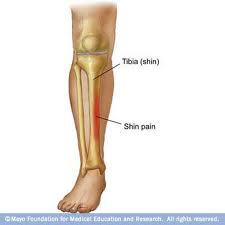One of the most common running injuries out there…shin splints. Almost every runner has had a time in their running experience where shin splints have been aggravating their every run. But not to worry! I’ve come to learn many ways to win the battle over shin splints.
Let’s start with what shin splints are and where they commonly come from among runners. Shin splints typically refer to pain along or just behind the tibia (shinbone), the large bone in the front of the lower leg. Shin splints occur for most runners when physical activity exceeds the amount of force the shinbone and connective tissue are used to taking.
Some of the most common reasons runners get shin splints are (in no particular order):
-Improper footwear
-Increasing your running mileage too fast (increasing mileage by about 10% per week is reasonably safe for most runners)
-An excess amount in downhill running
-Running on uneven surfaces (for example, always running on the same side of the road where the road seems to not be flat.)
-Improper running form (If you’re curious about this then we have some upcoming running classes!)
But what kind of things can be done to prevent and heal up these dreaded shin splints? Many runners are like my old High school track coach; his best advice for shin splints was always “Tuff up and run thru it!” However, that would NOT be my first recommendation!
Here are some things that tend to be the most beneficial for many runners:
- REST / cross train – use this time to build strength or perhaps do some cross training. Biking and swimming are a great way to low impact way to still built fitness thru many running injuries.
- Get fit for a good pair of running shoes – A lot of common alignment issues can be a very simple fix with a technical pair of running shoes.
- Massage / Stretch – Runners need to concentrate on giving their legs a deep tissue massage as often as possible. You’ll also benefit much more if you do a lot of small massage sessions compared to seldom longer massages. I find ‘The Stick’ works best for a lot of those smaller muscle groups below your knee.
- Compression sleeves/socks – Compression has been a huge hit lately. It’s almost surprising at how much it helps with things like shin splints. Not only does it help stimulate blood flow thru the compressed area, but also keeps the muscle vibrations that are causing shin splints to a minimum.
- Strengthening – focus on all the muscle below the knee but above your ankle
- Icing – ice the aggravated areas for about 10 minutes several times a day for the best results.
Shin splints can be a tricky injury to deal with! If you have any further questions or concerns, come on in to any of our three locations and talk to any of our trained employees for further information

